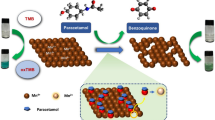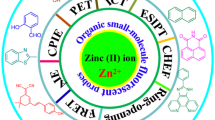Abstract
2-Pyrazoline containing benzothiazole ring 2-[1-(1,3-benzothiazol-2-yl)-5-(4-methoxyphenyl)-4,5-dihydro-1H-pyrazol-3-yl]phenol (BP) have been synthesized for the effective identification of picric acid over other competing nitro compounds using fluorescence technique. The pyrazoline BP showed quenching efficiency as high as 82% comparative to other nitro aromatics. The limit of detection and limit of quantification were found to be 1.1 μM and 3.3 μM. The possible mechanism with the quenched PA detection efficiency was based on fluorescence energy transfer and photoinduced electron transfer. Moreover, the observed results were supported by the optimized structures of the compounds using the DFT/B3LYP/6-311G/LanL2DZ method. Eventually, the pyrazoline derivative BP was further utilized for natural water samples, showing recoveries in the 87.62–101.09% and RSD was less than 3%.
Graphical Abstract














Similar content being viewed by others
Availability of Data and Material
Data and material information are provided and will be shared on request.
References
Nagendran S, Vishnoi P, Murugavel R (2017) Triphenylbenzene sensor for selective detection of picric acid. J Fluoresc 27:1299–1305
Acharyya K, Mukherjee PS (2014) A fluorescent organic cage for picric acid detection. Chem Commun 50(99):15788–15791
Lu H et al (2009) Experimentation and theoretic calculation of a BODIPY sensor based on photoinduced electron transfer for ions detection. J Phys Chem A 113(51):14081–14086
Zhang Y-P et al (2021) A novel fluorescent probe based on pyrazole-pyrazoline for Fe (III) ions recognition. J Fluoresc 31:29–38
Fabin M, Łapkowski M, Jarosz T (2023) Methods for detecting picric acid—a review of recent progress. Appl Sci 13(6):3991
Shyamal M et al (2017) Synthesis of an efficient Pyrene-based AIE active functional material for selective sensing of 2, 4, 6-trinitrophenol. J Photochem Photobiol, A 342:1–14
Karuppusamy A, Kannan P (2020) Effect of substitution on pyrazoline based donor-acceptor molecules as luminescent and their electrochemical properties. Chem Phys Lett 745:137241
Asiri AM et al (2019) Physicochemical and Photophysical investigation of newly synthesized carbazole containing pyrazoline-benzothiazole as a fluorescent chemosensor for the detection of Cu2+, Fe3+ & Fe2+ metal ion. J Mol Struct 1195:670–680
Ahmed M et al (2017) Fluorescent thiazol-substituted pyrazoline nanoparticles for sensitive and highly selective sensing of explosive 2, 4, 6-trinitrophenol in aqueous medium. Sens Actuators B Chem 248:57–62
Guo S et al (2021) High dual-state blue emission of a functionalized pyrazoline derivative for picric acid detection. CrystEngComm 23(1):221–226
Uchacz T et al (2019) Pyrazoline-based colorimetric and fluorescent probe for detection of sulphite. New J Chem 43(2):874–883
Saadallah ZF et al (2023) Synthesis and characterization of some pyrazolines derived from naproxen and evaluation of their biological activity. In AIP Conference Proceedings -AIP Publishing, (Vol. 2593, No. 1)
Asad M et al (2021) Design and synthesis of novel pyrazoline derivatives for their spectroscopic, single crystal X-ray and biological studies. J Mol Struct 1234:130131
Hu T et al (2023) Advances in portable heavy metal ion sensors. Sensors 23(8):4125
Xiong J-F et al (2014) Benzimidazole derivatives: selective fluorescent chemosensors for the picogram detection of picric acid. J Org Chem 79(23):11619–11630
Kumari S et al (2016) Highly sensitive fluorescent imidazolium-based sensors for nanomolar detection of explosive picric acid in aqueous medium. Sens Actuators B Chem 229:599–608
Béreau V, Duhayon C, Sutter J-P (2014) Supramolecular control over recognition and efficient detection of picric acid. Chem Commun 50(81):12061–12064
Sadia M et al (2023) Synthesis and computational study of an optical fluorescent sensor for selective detection of Ni2+ ions. ACS Omega 8(30):27500–27509
Sathiyan G et al (2019) A novel star-shaped triazine-triphenylamine–based fluorescent chemosensor for the selective detection of picric acid. Mater Today Chem 12:178–186
Zhang W et al (2022) Polyfluorene based fluorescent sensor for sensitive and selective detection of picric acid. Mater Lett 306:130860
Bhalla V, Gupta A, Kumar M (2012) Fluorescent nanoaggregates of pentacenequinone derivative for selective sensing of picric acid in aqueous media. Org Lett 14(12):3112–3115
Nailwal Y, Devi M, Pal SK (2022) Luminescent conjugated microporous polymers for selective sensing and ultrafast detection of picric acid. ACS Appl Polym Mater 4(4):2648–2655
Bauri K et al (2017) A nonconjugated macromolecular luminogen for speedy, selective and sensitive detection of picric acid in water. Polym Chem 8(46):7180–7187
Sharma P et al (2022) Experimental and theoretical studies of the pyrazoline derivative 5-(4-methylphenyl)-3-(5-methylfuran-2-yl)-1-phenyl-4, 5-dihydro-1 H-Pyrazole and its application for selective detection of Cd2+ ion as fluorescent sensor. J Fluoresc 32(3):969–981
Sharma P et al (2022) Fluorescence “turn-off” sensing of iron (III) Ions utilizing pyrazoline based sensor: Experimental and computational study. J Fluoresc 32(6):2319–2331
Goel A, Malhotra R (2022) Efficient detection of Picric acid by pyranone based Schiff base as a chemosensor. J Mol Struct 1249:131619
Madhu P, Sivakumar P (2019) Curcumin-based fluorescent chemosensor for selective and efficient detection of picric acid. J Mol Struct 1185:410–415
Mostakim S, Biswas S (2016) A thiadiazole-functionalized Zr (IV)-based metal–organic framework as a highly fluorescent probe for the selective detection of picric acid. CrystEngComm 18(17):3104–3113
Arulraj R et al (2020) Synthesis, vibrational spectra, DFT calculations, Hirshfeld surface analysis and molecular docking study of 3-chloro-3-methyl-2, 6-diphenylpiperidin-4-one. Spectrochim Acta Part A Mol Biomol Spectrosc 232:118166
Azhagiri S et al (2014) Molecular structure, Mulliken charge, frontier molecular orbital and first hyperpolarizability analysis on 2-nitroaniline and 4-methoxy-2-nitroaniline using density functional theory. Spectrochim Acta Part A Mol Biomol Spectrosc 124:199–202
Khan J et al (2022) Development of [(2E, 6E)-2, 6-bis (4-(dimethylamino) benzylidene) cyclohexanone] as fluorescence-on probe for Hg2+ ion detection: Computational aided experimental studies. Arab J Chem 15(4):103710
Kaur M, Yusuf M, Malik AK (2021) Synthesis of copper metal organic framework based on Schiff base tricarboxylate ligand for highly selective and sensitive detection of 2, 4, 6-trinitrophenol in aqueous medium. J Fluoresc 31(6):1959–1973
Sarvestani MJ, Charehjou P (2021) Fullerene (C20) as a potential adsorbent and sensor for the removal and detection of picric acid contaminant: DFT studies. Cent Asian J Environ Sci Technol Innov 2(1):12–19
Formenti M et al (2022) Pyrene-substituted cyclic triimidazole: An appealing and versatile luminescent scaffold for explosive detection. Dyes Pigm 206:110637
Zheng W et al (2022) Rapid and selective detection of picric acid based on supramolecular self-assembly of a cationic perylene diimide in pure aqueous media. Dyes Pigm 207:110761
Mohan JM et al (2021) Optimized ink jetted paper device for electroanalytical detection of picric acid. Colloids Surf B 208:112056
Patra SK et al (2022) An aggregation-induced emission-active bis-heteroleptic ruthenium (ii) complex of thiophenyl substituted phenanthroline for the selective “turn-off” detection of picric acid. New J Chem 46(1):169–177
Shafizadeh M et al (2022) Chlorophyll-based wicking sensing bioplatform coupled with a smartphone-based sample-to-answer analytical device for on-site detection of picric acid. Biosens Bioelectron: X 11:100150
Kayhomayun Z, Ghani K, Zargoosh K (2022) Synthesis of samarium orthoferrite-based perovskite nanoparticles as a turn-on fluorescent probe for trace level detection of picric acid. Spectrochim Acta Part A Mol Biomol Spectrosc 281:121627
Acknowledgements
The authors (PS, MY, and AKM) acknowledge the UGC-SAP and Chemistry Department, Punjabi University, Patiala, for providing lab and instrument facilities and RIMT University, Mandi Gobindgarh for providing internet facilities.
Author information
Authors and Affiliations
Contributions
Promila Sharma: Performed the experimentation. Mohammad Yusuf and Ashok Kumar Malik: Helped in writing and supervised the research work.
Corresponding author
Ethics declarations
Ethics Approval
There are no ethics approvals required for this research work.
Consent to Participate
All authors will participate in the revision of the manuscript.
Consent for Publication
All authors agree to the publication.
Conflicts of Interest/Competing Interests
All the authors declare that there is no conflict of interest.
Additional information
Publisher's Note
Springer Nature remains neutral with regard to jurisdictional claims in published maps and institutional affiliations.
Highlights
• Synthesized 2-pyrazoline containing benzothiazole used for low-cost, simple, and selective detection of picric acid.
• Efficient sensitivity to picric acid is expressed even in the presence of other competing nitroaromatic compounds.
• Mechanistic route prompt by FRET and PET processes.
• Experimental observation boosted by density functional theory.
Supplementary Information
Below is the link to the electronic supplementary material.
Rights and permissions
Springer Nature or its licensor (e.g. a society or other partner) holds exclusive rights to this article under a publishing agreement with the author(s) or other rightsholder(s); author self-archiving of the accepted manuscript version of this article is solely governed by the terms of such publishing agreement and applicable law.
About this article
Cite this article
Sharma, P., Yusuf, M. & Malik, A.K. Pyrazoline-Based Fluorescent Probe: Synthesis, Characterization, Theoretical Simulation, and Detection of Picric Acid. J Fluoresc (2023). https://doi.org/10.1007/s10895-023-03414-w
Received:
Accepted:
Published:
DOI: https://doi.org/10.1007/s10895-023-03414-w




